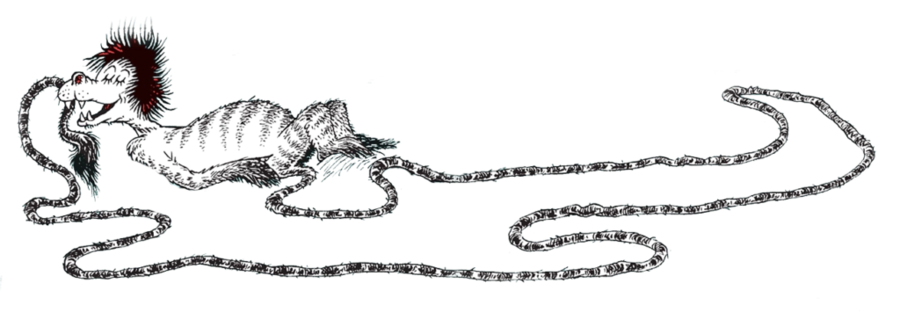Post by Scott Atkins, undergraduate in Perception course at Portland State University

“Dad, you’re thinking about it too much! Just read the story,” she said. Or at least, she seemed to say (she’s only two, after all). But my daughter was right. While reading a book about wildly fantastic creatures, I was too busy overthinking how these creatures could exist in real life.
The book in question was Dr. Seuss’ Sleep Book. In it, the author runs through a menagerie of animals, each with a different sleep habit. We had come upon the Chippendale Mupp, who bites his tail before going to sleep. Exactly eight hours later, the pain of that bite reaches his brain, which awakens the beast without need for an alarm clock.

The Chippendale Mupp
And of course, I had to know: “Just how long do you think his tail is?”
“What do you mean? It looks pretty long in the picture,” my daughter pointed out.
“Right, but in real life,” I clarified. “How long would his tail need to be in order for pain to take eight hours to register in his brain?” Luckily, I just learned about the perception of pain from Dr. Griesar, and so I had a clue about how to figure this out.

Perception course at Portland State University
“See, a bite causes a sharp, sudden pain (as opposed to an enduring, persistent one). The damage to your skin is picked up by special sensory neurons called nociceptors and transmitted over myelinated A-delta nerves to your brain, where you actually feel the pain. It looks like the signals ride along these lines as fast as 35 meters per second, give or take. The math yields a tail length of 1,008,000 meters, or about 625 miles!”
“What if the bite causes enduring pain?” she asked. “You said ‘as opposed to enduring pain.’”

LEARN MORE: Nociceptors: the sensors of the pain pathway
“Oh, then the nociceptor would hook up to an unmyelinated C fiber. It’s slower, like two meters per second. So a tail length of only 57,600 meters, or 36 miles. Much more manageable, but a bite doesn’t seem like that type of pain.”

“Suppose it is, though,” she suggested.
“Why? A bite is a sharp pain. It’s definitely an A-delta nerve. It must have a tail hundreds of miles long.”
“You’re thinking about it too much! This is a fantasy story. If you’re going to imagine that it’s real, why selectively impose some rules of our reality while ignoring others?”
“Such as?”
“Such as the fact that a tail like that would require an enormous amount of energy to grow, and it would be an incredible liability to the animal. Any predator could come along, severely injure it, and the poor guy wouldn’t even know for up to eight hours!”
“Oh yeah… I hadn’t thought about those implications.” She’s a sharp one for such a young age. “What do you suggest?” I asked.
“It’s fantasy. Just accept it as is! He has a short tail, and it works like that just because it does!”

“Accept fantasy at face value?!” I scoffed. “But this is science!!” I was tempted to argue the principal of the matter, but I decided to play along. “Ok, suppose he does have a normal length tail… but with an incredibly long neuron inside it.”
“How would that even work?”
“It could work! The neuron’s all coiled and bunched up inside there, like a radio antenna.”
“What’s a radio ant-”
“Nevermind. Anyway, I think that’s how his tail works. Maybe we could figure out the length of a coiled neuron! Except that might involve geometry or something…”
“Dad, you’re thinking about it too much! Just read the story,” she said.

Or at least, she seemed to say.


